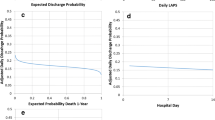ABSTRACT
BACKGROUND
Achieving patient–physician continuity is difficult in the inpatient setting, where care must be provided continuously. Little is known about the impact of hospital physician discontinuity on outcomes.
OBJECTIVE
To determine the association between hospital physician continuity and percentage change in median cost of hospitalization, 30-day readmission, and patient satisfaction with physician communication.
DESIGN
Retrospective observational study using various multivariable models to adjust for patient characteristics.
PARTICIPANTS
Patients admitted to a non-teaching hospitalist service in a large, academic, urban hospital between 6 July 2008 and 31 December 2011.
MAIN MEASURES
We used two measures of continuity: the Number of Physicians Index (NPI), and the Usual Provider of Continuity (UPC) index. The NPI is the total number of unique physicians caring for a patient, while the UPC is calculated as the largest number of patient encounters with a single physician, divided by the total number of encounters. Outcome measures were percentage change in median cost of hospitalization, 30-day readmissions, and top box responses to satisfaction with physician communication.
KEY RESULTS
Our analyses included data from 18,375 hospitalizations. Lower continuity was associated with modest increases in costs (range 0.9–12.6 % of median), with three of the four models used achieving statistical significance. Lower continuity was associated with lower odds of readmission (OR = 0.95–0.98 across models), although only one of the models achieved statistical significance. Satisfaction with physician communication was lower, with less continuity across all models, but results were not statistically significant.
CONCLUSIONS
Hospital physician discontinuity appears to be associated with modestly increased hospital costs. Hospital physicians may revise plans as they take over patient care responsibility from their colleagues.
Similar content being viewed by others
REFERENCES
Saultz JW, Lochner J. Interpersonal continuity of care and care outcomes: a critical review. Ann Fam Med. 2005;3:159–66.
van Walraven C, Oake N, Jennings A, Forster AJ. The association between continuity of care and outcomes: a systematic and critical review. J Eval Clin Pract. 2010;16:947–56.
Saultz JW, Albedaiwi W. Interpersonal continuity of care and patient satisfaction: a critical review. Ann Fam Med. 2004;2:445–51.
Blankfield RP, Kelly RB, Alemagno SA, King CM. Continuity of care in a family practice residency program. Impact on physician satisfaction. J Fam Pract. 1990;31:69–73.
Fletcher KE, Sharma G, Zhang D, Kuo YF, Goodwin JS. Trends in inpatient continuity of care for a cohort of Medicare patients 1996–2006. J Hosp Med. 2011;6:438–44.
Epstein K, Juarez E, Epstein A, Loya K, Singer A. The Impact of Fragmentation of Hospitalist Care on Length of Stay. J Hosp Med. 2010;5:335–8.
Steinwachs DM. Measuring provider continuity in ambulatory care: an assessment of alternative approaches. Med Care. 1979;17:551–65.
Saultz JW. Defining and measuring interpersonal continuity of care. Ann Fam Med. 2003;1:134–43.
Consumer Price Index Tables. 2013. Available at http://www.bls.gov/cpi/tables.htm. Accessed November 23, 2013.
CAHPS Home. Available at https://cahps.ahrq.gov/. Accessed November 23, 2013.
HCUP Clinical Classification Software Agency for Healthcare Research and Quality. Available at http://www.hcup-us.ahrq.gov/toolssoftware/ccs/ccs.jsp. Accessed November 23, 2013.
HCAHPS Hospital Survey. Available at http://www.hcahpsonline.org/home.aspx. Accessed November 23, 2013.
van Walraven C, Austin PC, Jennings A, Quan H, Forster AJ. A modification of the Elixhauser comorbidity measures into a point system for hospital death using administrative data. Med Care. 2009;47:626–33.
Valenstein P, Leiken A, Lehmann C. Test-ordering by multiple physicians increases unnecessary laboratory examinations. Arch Pathol Lab Med. 1988;112:238–41.
Wachter RM. Does continuity of care matter? No: discontinuity can improve patient care. West J Med. 2001;175:5.
Kuo YF, Sharma G, Freeman JL, Goodwin JS. Growth in the care of older patients by hospitalists in the United States. N Engl J Med. 2009;360:1102–12.
State of Hospital Medicine Report. 2012 Report Based on 2011 Data.: Society of Hospital Medicine and the Medical Group Management Association; 2012.
Chandra S, Wright SM, Howell EE. The Creating Incentives and Continuity Leading to Efficiency staffing model: a quality improvement initiative in hospital medicine. Mayo Clin Proc. 2012;87:364–71.
Acknowledgements
Contributors
The authors wish to thank Donald Steinwachs, PhD, Professor in the Center for Health Services and Outcomes Research at Johns Hopkins Bloomberg School of Public Health, for discussing the selection of continuity metrics. He has not received compensation for this contribution.
Funders
This project was supported by an Excellence in Academic Medicine Award, administered by Northwestern Memorial Hospital.
Prior Presentations
This study was presented at the Society of Hospital Medicine meeting on 3 April 2012.
Conflict of Interest
The authors declare that they do not have a conflict of interest or financial disclosures to make.
Author information
Authors and Affiliations
Corresponding author
Rights and permissions
About this article
Cite this article
Turner, J., Hansen, L., Hinami, K. et al. The Impact of Hospitalist Discontinuity on Hospital Cost, Readmissions, and Patient Satisfaction. J GEN INTERN MED 29, 1004–1008 (2014). https://doi.org/10.1007/s11606-013-2754-0
Received:
Revised:
Accepted:
Published:
Issue Date:
DOI: https://doi.org/10.1007/s11606-013-2754-0




